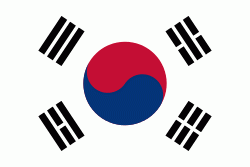Yeongdeungpo-gu
Yeongdeungpo District is an administrative district in southwest Seoul, South Korea. Although the origin of the name is uncertain, the first two syllables are thought to be from "yeongdeung" (靈登) or "divine ascent", a shamanic rite. The third syllable is "po", representing the bank of a river (浦), referring to the district's position on the Han River. The 2006 population was 408,819.
There are 22 administrative "dong" and 34 legal "dong". Yeouido-dong is the largest in area and takes up about 34% of the land. The total area is 24.56 km2 (2004), making up 4% of Seoul's land. The annual budget is approximately 2 billion won.
Yeongdeungpo District has been heavily developed as an office, commercial, and residential district. Yeouido Dong is home to DLI 63 Building, the highest office building in South Korea and currently the 3rd tallest building in the country. The National Assembly Building is located in Yeouido-dong. Other organisations, such as the Financial Union of Korea are also based in Yeongdeungpo. There are also mass-media corporations in the area, including; Kookmin Newspaper Corporation; Munhwa Broadcasting Corporation and Korean Broadcasting System.
The earliest historical references to Yeongdeungpo were in the 1870s when it was considered to be the main port used in the defence of the city of Seoul.
The opening of the Gyeongin Line in 1899 and the Gyeongbu Line 1905, the County Office of Siheung-gun was relocated to Yeongdeungpo and area became a major hub for transportation and commerce.
Except for Yeouido and Yanghwa-dong, Yeongdeungpo belonged to old Siheung County. In 1936, Yeongdeungpo (except for today's Daerim-dong) was annexed to Gyeongseong (today's Seoul). In 1949, some parts of Siheung County were ceded to Yeongdeungpo District of Seoul. These sections are today's Guro-dong, Sindorim-dong, Daerim-dong and Sindaebang-dong. It is one of the sub-centers of Seoul, and the Seoul Metropolitan Subway Line 1 passes. Among the areas south of the Han River in present-day Seoul, it was the first (1936) to be incorporated into Seoul.
January 1, 1963, Some areas of Bucheon County were combined to Yeongdeungpo District as below.
Also, many parts of Siheung County were merged into this district at the same time.
During the post-Korean War industrialization period the district's economy and population grew dramatically and as a result sections of the district were broken up to form new districts – Gwanak-gu being established in 1973, Gangseo-gu in 1977, and Guro-gu in 1980.
There are 22 administrative "dong" and 34 legal "dong". Yeouido-dong is the largest in area and takes up about 34% of the land. The total area is 24.56 km2 (2004), making up 4% of Seoul's land. The annual budget is approximately 2 billion won.
Yeongdeungpo District has been heavily developed as an office, commercial, and residential district. Yeouido Dong is home to DLI 63 Building, the highest office building in South Korea and currently the 3rd tallest building in the country. The National Assembly Building is located in Yeouido-dong. Other organisations, such as the Financial Union of Korea are also based in Yeongdeungpo. There are also mass-media corporations in the area, including; Kookmin Newspaper Corporation; Munhwa Broadcasting Corporation and Korean Broadcasting System.
The earliest historical references to Yeongdeungpo were in the 1870s when it was considered to be the main port used in the defence of the city of Seoul.
The opening of the Gyeongin Line in 1899 and the Gyeongbu Line 1905, the County Office of Siheung-gun was relocated to Yeongdeungpo and area became a major hub for transportation and commerce.
Except for Yeouido and Yanghwa-dong, Yeongdeungpo belonged to old Siheung County. In 1936, Yeongdeungpo (except for today's Daerim-dong) was annexed to Gyeongseong (today's Seoul). In 1949, some parts of Siheung County were ceded to Yeongdeungpo District of Seoul. These sections are today's Guro-dong, Sindorim-dong, Daerim-dong and Sindaebang-dong. It is one of the sub-centers of Seoul, and the Seoul Metropolitan Subway Line 1 passes. Among the areas south of the Han River in present-day Seoul, it was the first (1936) to be incorporated into Seoul.
January 1, 1963, Some areas of Bucheon County were combined to Yeongdeungpo District as below.
Also, many parts of Siheung County were merged into this district at the same time.
During the post-Korean War industrialization period the district's economy and population grew dramatically and as a result sections of the district were broken up to form new districts – Gwanak-gu being established in 1973, Gangseo-gu in 1977, and Guro-gu in 1980.
Map - Yeongdeungpo-gu
Map
Country - South_Korea
 |
 |
| Flag of South Korea | |
The Korean Peninsula was inhabited as early as the Lower Paleolithic period. Its first kingdom was noted in Chinese records in the early 7th century BCE. Following the unification of the Three Kingdoms of Korea into Silla and Balhae in the late 7th century, Korea was ruled by the Goryeo dynasty (918–1392) and the Joseon dynasty (1392–1897). The succeeding Korean Empire (1897–1910) was annexed in 1910 into the Empire of Japan. Japanese rule ended following Japan's surrender in World War II, after which Korea was divided into two zones; a northern zone occupied by the Soviet Union and a southern zone occupied by the United States. After negotiations on reunification failed, the southern zone became the Republic of Korea in August 1948 while the northern zone became the communist Democratic People's Republic of Korea the following month.
Currency / Language
| ISO | Currency | Symbol | Significant figures |
|---|---|---|---|
| KRW | South Korean won | â‚© | 0 |
| ISO | Language |
|---|---|
| EN | English language |
| KO | Korean language |















